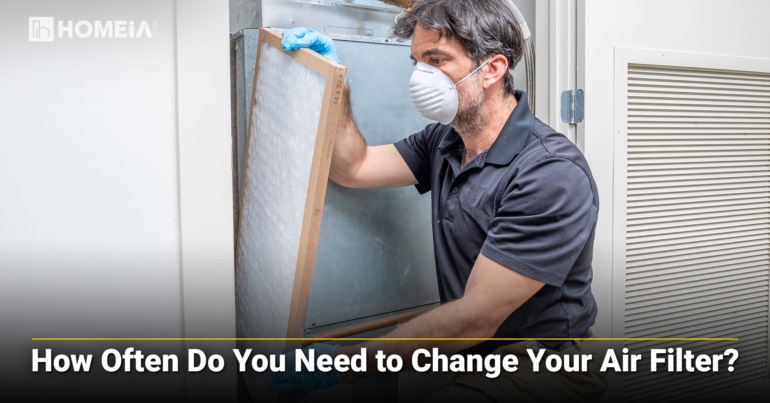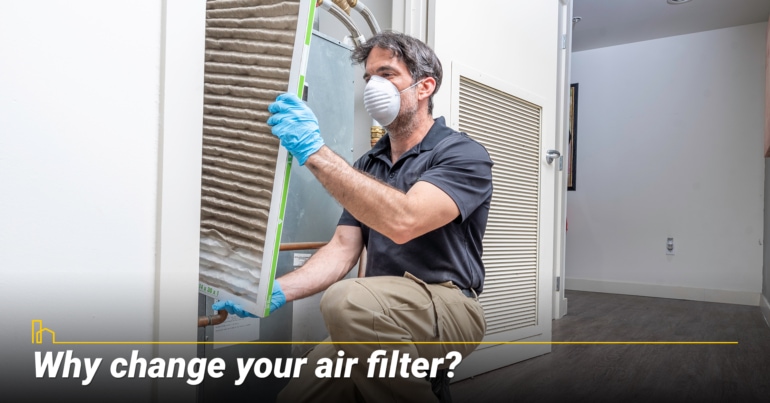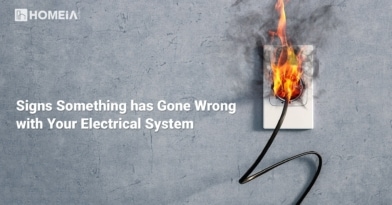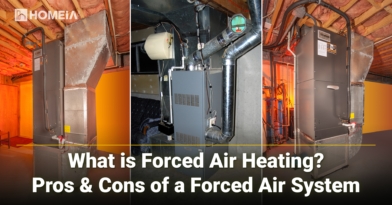How Often Do You Need to Change Your Air Filter?
- Local Editor:Local Editor: The HOMEiA Team
Published: May 05, 2022
- Category: Home Maintenance , Home Improvement

When was the last time you changed your home’s air filter? If you can’t remember, it’s probably time to do it again. And if you’ve never changed it, get ready to add a new task to your to-do list. Experts say most homeowners should change their air filters every three months.
If you haven’t been changing yours on schedule, don’t panic. It’s generally an easy maintenance task that doesn’t require any special skills.
But first, let’s look at what your air filter does and why you need to change it.
Table of Contents:
1. What does your air filter do?

Your air filter is part of your HVAC system — heating, ventilation and air conditioning. Its job is to collect particles and contaminants as the air passes through the system. Depending on the level of filtration, it can block dust, dirt, pet hair, carpet fibers, lint, mold and even bacteria.
That’s important for two reasons. First, the filter keeps these particles out of the HVAC’s sensitive equipment. Without a working filter, dust can build up and jam moving parts, like valves and fan motors.
Second, the filter catches contaminants out of the air as it cycles through the system, so the air that is released back into the house is cleaner for you to breathe.
The Best 10 Ways to Maintain Your House
Your house is most likely the most expensive purchase of your lifetime — and a safe haven that provides a hub for everyday activities, relaxation and making memories. It doesn’t remain in great shape without some effort, but with some loving care and an organized maintenance schedule, you can manage the upkeep without added stress...
2. Why change your air filter?

When an air filter does its job, it starts to fill up with dust and dirt. Eventually this buildup makes it harder for air to pass through the filter. That means the HVAC system has to work harder to push the air through. The system becomes less efficient, and you end up with higher utility bills.
Additionally, the harder the system has to work, the more wear and tear — and that can cause parts to malfunction, leading to expensive repair bills.
Signs Something Has Gone Wrong with Your Electrical System
Fortunately, it’s not hard to make sure your electrical system stays in tip-top shape. Just pay attention once in a while and notice if there are any signs of trouble. Here’re 9 big signs that your electrical system has a problem—and what to do to keep the problem from growing even…
3. What type of air filter do you need?

Air filters come in a variety of materials and styles, as well as different filtration levels and price points. You’ll be limited to sizes and strengths that fit your system, but the rest will depend on your specific needs and your budget.
Your first step is to determine what kind of filter your system will accept. The best place to start is your product manual. If you can’t find it, look up your model online. (As a last resort, look at your existing filter and note any identifying information.)
You are looking for the proper filter size (length, width and thickness) and the approved MERV ratings for your unit.
What is a MERV rating? It stands for “Minimum Efficiency Reporting Value,” and it expresses how well the filter removes certain sizes of particles from the air.
MERV ratings range from 1 to 20, but ratings above 16 are generally reserved for the filters used in highly sensitive environments, like operating rooms and clean rooms. On the 1 to 16 scale of typical filters, a higher number means the filter is better at catching the smallest particles.
So highest is best, right? Not necessarily.
Just as an HVAC system has to work harder to push air through a dirty filter, it also has to work harder to push air through a denser filter. Some systems are not strong enough to handle highly rated filters, or they may simply run more efficiently with lower-rated filters.
Once you know what your system will accept, you can evaluate the different types of filters and choose the one that best fits your needs and budget.
What is Forced Air Heating? Pros & Cons of a Forced Air System
Forced air heating systems are the most popular home heating systems in North America. But how do they work? And are they right for all homeowners, or are there other options? Here we’ll explore how a forced air system works and take a look at its Pros and Cons. Then we’ll introduce a few alternatives that may work for certain homeowners…
Here are the most common types:
- Flat-panel. Generally made of spun fiberglass, these are the least expensive and also the lowest-rated. They’re easy to find in stores and are often blue in color. Flat-panel filters typically rate between 1 and 4 on the MERV scale. They may need to be changed as often as once a month.
- Pleated. These filters are usually made of cotton, polyester blend or plastic fiber material that is folded to create more surface area. They filter more efficiently than flat-panel filters and tend to have MERV ratings from 5 to 8. They need to be replaced about every three months.Some pleated filters have even higher MERV ratings, up to about 13, and these trap even tinier particles. These filters tend to be thicker (2 to 5 inches), and they fit into box-like frames that are mounted on the air handler. They may last around six months; check the package.
- Electrostatic. Available in either flat or pleated forms, electrostatic filters use static to trap smaller particles than typical filters, allowing them to capture pollen, smoke and even bacteria.
- Washable. Washable filters come in an aluminum frame and are encased in aluminum mesh. They can be hosed or vacuumed to clean them — every one to three months or so — and they must be allowed to dry completely before reuse. While they lose their electrostatic charge over time, they can last as long as five to ten years.
Recommended for you
4. How often do you actually need to change your filters?

It is highly recommended that you should change your air filter in your home every 1 or 2 months. There are three ways to determine when it’s time to change your filter. You can set a schedule based on your home’s usage, check regularly to see if your filter is dirty, or choose a “smart filter” that will notify you when it needs to be changed.
If you want to change your filter on a set schedule, there are several factors you should consider when determining the frequency. In general, consider changing your filter every one to three months.
- Home size. Larger homes move more air through their filters, so the filters will need to be changed more often. Note, however, that smaller homes may have smaller HVAC systems and filters, so they may have to be changed just as frequently.
- Outdoor air quality. If you live in an area with lots of smog, dust, or wildfire smoke, you may need to change your filter more often.
- Pets. Fur and dander can cause filters to get dirty quickly.
- Occupancy. The more people in the house, and the more time they spend there, the faster the filter will get dirty. A rarely-occupied vacation home, on the other hand, might only need a filter change every nine to 12 months.
- Allergies. People with serious allergies may want to change their filters as often as every 20 days.
- Season. In the spring and fall, you may use your heating and cooling systems less often. The reduced load could mean your filters will stay clean and functional longer. The opposite is true in the summer or winter, when the air conditioner or furnace may be running most of the time.
- Windows. If you keep your windows open, your filter will work harder to handle pollen and other environmental particles and may need more frequent changes.
If you would rather change your filter only when necessary, you can schedule a monthly check. In order to inspect your filter visually, remove it from its slot and hold it up to the light. If you cannot see light through the filter, it’s time for a new one.
Another option is to install a smart filter. Products such as 3M’s Filtrete Smart Air Filters have sensors built into them to measure air flow. When the sensor detects reduced air flow, it notifies the user via mobile app to change the filter.
Recommended for you
5. How to Change Your Air Filter

Once you’ve purchased a replacement filter, the process of changing it is simple. The hardest part is figuring out where it goes.
First, find your furnace and/or air conditioning unit. It’s probably in the basement, but it may be in the attic or, especially in an apartment, in a closet.
Next, look for the air handler — a big metal box that contains the fan and its motor. Most of the time, the filter is located on the intake side of the air handler. Look for a long, narrow cover and open it. Do you see a filter inside? If so, you’ve found the right spot.
If you’ve looked all over the air handling unit (noting that the filter slot can be vertical or horizontal) and you still haven’t found the right place, your filter may be located at an air return vent. Look for an extra-large vent on the wall (or occasionally the floor or ceiling).
Once you’ve found the place where your filter goes, your next step is to turn off the unit. Then remove the panel covering the filter slot and pull out the old filter. Place it in a plastic bag (taking care not to bump or shake it), seal the bag and dispose of it in the trash.
On the new filter, look for the arrows that indicate the direction of air flow. Slide the new filter into the slot with the arrows pointing toward the HVAC unit and away from the incoming cool air.
Finally, replace the cover panel and turn the unit back on.
A Guide to Drain Cleaning for Your Home
Although there are a lot of different ideas out there on how to keep your drains clean, most people agree on one thing: chemicals should be at the bottom of the list. Here’s a quick guide to help you make the most of drain cleaning around your home…
6. Where to buy air filters

Common types of replacement air filters are readily available in hardware stores and big box stores. You can also buy Honeywell air filters online from general retailers or from specialized sites that may offer more guidance and better prices.
We hope you find this article helpful, if you do, please share it with others on Facebook or LinkedIn so they can benefit from it as well. Thanks in advance!
How to Raise Your Home’s Value with Bathroom Renovations
Bathroom renovations are an excellent way to add value to your home. As with any remodeling project, however, you can’t expect to recoup the entire cost of the project when you sell. Remodel Magazine puts the expected value of a midrange bathroom redo at 64 percent of the price tag. If you should happen to sell the house in the future, you’ll…
HOMEiA is a city guide site where visitors can find detailed information about communities of interest. HOMEiA’s City Guides, created in partnership with local writers and editors, are curated lists of the best, safest, and most affordable places to live. The guides feature the HOMEiA Score, a proprietary index that rates communities on such factors as housing costs, education, employment, etc.
HOMEiA.com aims to be the premier site for people planning to relocate, providing them with insightful content and connecting them with skilled real estate professionals.
We also empower real estate professionals to establish or strengthen their web presence by highlighting their experience, knowledge and achievements. If you’re selected to join our list of certified real estate professionals, you will distinguish yourself from your peers — and earn HOMEiA’s support.
If you believe in HOMEiA’s mission, please share our website with others.










































































































































